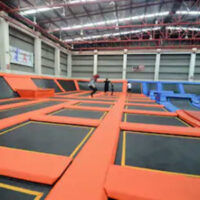Kids Can Get Really Injured at Trampoline Parks

Through the years, different forms of amusement for kids and adults become popular. One type of recreational activity that’s becoming more and more common are trampoline parks. But while they are experiencing a rise in popularity, they also signal a potential rise in accidents and injuries.
What are Trampoline Parks?
Trampoline parks are indoor recreational facilities that are filled with trampolines. Entire floors may be trampoline, walls may be trampoline, and there may even be other accessories, such as basketball hoops or zip lines or climbing walls, surrounding or around the trampolines.
Many of these facilities have become popular for exercise, to get out of the summer heat, or for kids’ birthday parties.
Potential Hazards and Dangers
But many parents don’t realize the risks, when things go wrong at trampoline parks.
The danger in many parks is the intermixing of kids of different ages, sizes and weights on the trampoline floor at the same time. This is because below the trampoline, is the floor of the facility.
What can happen is that if there is a larger child jumping, and thus, pushing the trampoline downward, and at the same time, and close to that child, is another child, also going downward on the trampoline, the combined force or weight of both kids’ bodies going down on the trampoline floor, is enough to push it all the way down to the hard facility (actual, real) floor underneath.
That can lead to broken knees, ankles and feet, as the trampoline doesn’t have enough force to keep all that weight high enough.
This is often the case when larger kids jump on the trampoline with smaller kids; the larger kids push the trampoline down, and the smaller ones push it further down.
And when it’s not feet that are going down—when it’s a head or a shoulder landing on the trampoline floor, which is now hardened by touching the facility floor below it, there can be real catastrophe.
The Floor Coming Up
But it’s not just the trampoline going too far down that causes injury. It’s also the rebound effect, when the trampoline floor is springing back up.
Again, imagine a large child jumping on the trampoline floor. The more the floor is pushed downward, the stronger and harder it will thrust upward on the rebound. Now imagine a small child next to the large child. The small child is jumping on the trampoline floor, as it is rebounding upwards from the bigger child’s jump.
That springing back up can make the trampoline floor a dangerous object—the force of it coming back up into a smaller child’s legs, head, or ankles, can cause serious injury to another child.
No Laws That Control Trampoline Parks
There are no laws that regulate trampoline parks, and many parks do a substandard job of monitoring kids or regulating how many kids are jumping at the same time. Worse, many customers have harmless agreements to try to avoid liability.
Injured at a trampoline park? Contact the Tampa personal injury lawyers at Barbas, Nunez, Sanders, Butler & Hovsepian and schedule a consultation today.
Source:
northernvirginia.legalexaminer.com/legal/beware-before-you-bounce-the-dangers-of-trampoline-parks/




